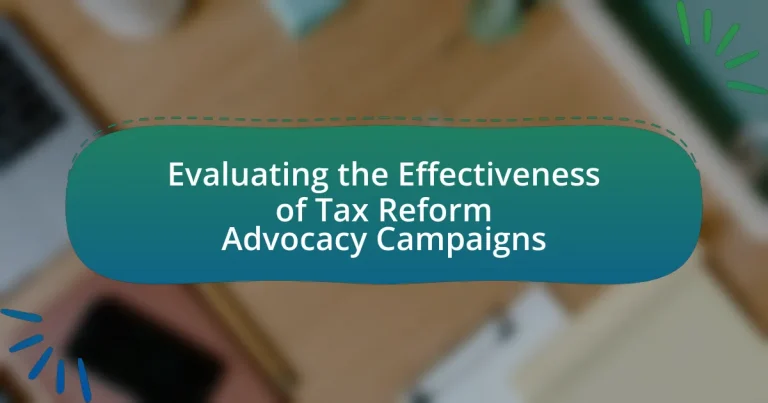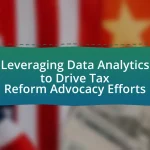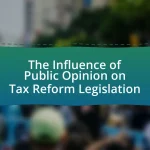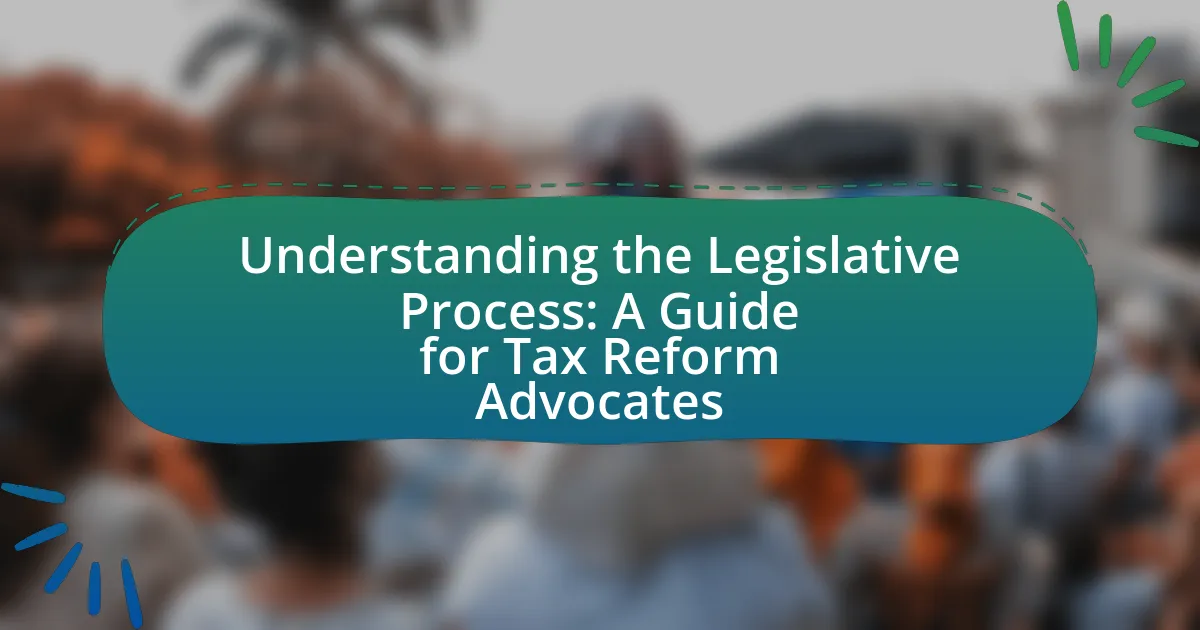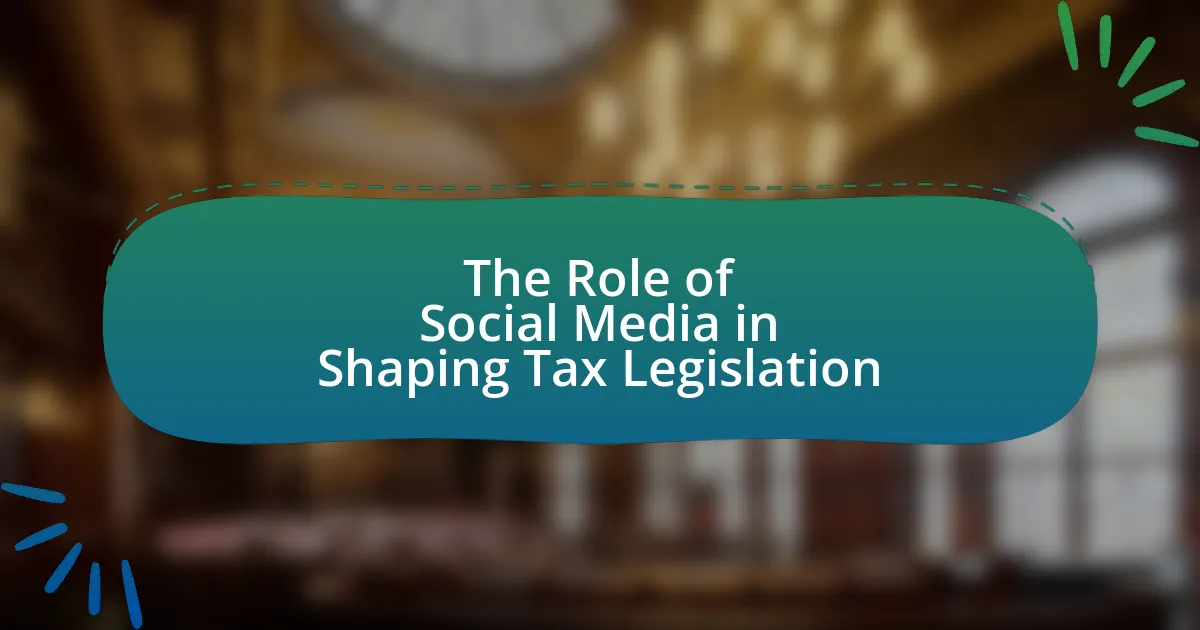Tax reform advocacy campaigns are organized efforts aimed at influencing public policy and legislative changes related to taxation, involving stakeholders such as non-profit organizations, think tanks, and grassroots movements. These campaigns are crucial for raising awareness about tax issues, promoting specific reforms, and mobilizing public support to create a fairer and more efficient tax system. The article evaluates the effectiveness of these campaigns by examining their goals, strategies, and the roles of key stakeholders, as well as the challenges faced in measuring their impact. It also highlights best practices for conducting successful campaigns and draws insights from past initiatives to inform future approaches.

What are Tax Reform Advocacy Campaigns?
Tax reform advocacy campaigns are organized efforts aimed at influencing public policy and legislative changes related to taxation. These campaigns often involve various stakeholders, including non-profit organizations, think tanks, and grassroots movements, working to raise awareness about tax issues, promote specific reforms, and mobilize public support. For example, campaigns may focus on reducing tax rates, closing loopholes, or increasing transparency in tax systems, with the goal of creating a fairer and more efficient tax structure. Evidence of their impact can be seen in historical instances where advocacy led to significant tax legislation changes, such as the Tax Reform Act of 1986 in the United States, which was influenced by extensive lobbying and public campaigns.
Why are Tax Reform Advocacy Campaigns important?
Tax reform advocacy campaigns are important because they mobilize public support for necessary changes in tax policy, aiming to create a fairer and more efficient tax system. These campaigns raise awareness about the implications of current tax laws and advocate for reforms that can lead to economic growth, equity, and improved public services. For instance, the Tax Policy Center reported that effective advocacy can influence legislative outcomes, as seen in the successful push for the Tax Cuts and Jobs Act of 2017, which was shaped by extensive lobbying and public campaigns.
What goals do these campaigns aim to achieve?
The goals of tax reform advocacy campaigns aim to influence policy changes, increase public awareness, and mobilize support for specific tax reforms. These campaigns seek to persuade lawmakers to adopt more equitable tax policies, reduce tax burdens on certain demographics, or enhance government revenue through reforms. For instance, campaigns often highlight the economic benefits of tax reform, such as increased investment and job creation, to garner public and political support.
How do these campaigns influence public policy?
Tax reform advocacy campaigns influence public policy by mobilizing public opinion and shaping legislative agendas. These campaigns often utilize targeted messaging and grassroots organizing to raise awareness about specific tax issues, thereby increasing public engagement and pressure on policymakers. For instance, campaigns that highlight the benefits of tax reform for economic growth can lead to increased support among constituents, prompting legislators to prioritize tax reform initiatives in their agendas. Research indicates that campaigns with strong public backing can result in significant policy changes, as seen in the 2017 Tax Cuts and Jobs Act, where advocacy efforts played a crucial role in garnering support for the legislation.
Who are the key stakeholders in Tax Reform Advocacy Campaigns?
Key stakeholders in Tax Reform Advocacy Campaigns include government officials, advocacy organizations, businesses, and the general public. Government officials, such as legislators and policymakers, play a crucial role in shaping tax laws and regulations. Advocacy organizations, including think tanks and non-profits, mobilize public opinion and provide research to support reform efforts. Businesses, particularly those affected by tax policies, engage in lobbying to influence tax legislation. Lastly, the general public, as taxpayers, can impact reform through voting and public discourse, highlighting the importance of grassroots support in these campaigns.
What roles do advocacy groups play?
Advocacy groups play crucial roles in influencing public policy and shaping societal norms. They engage in activities such as lobbying government officials, raising public awareness, and mobilizing community support to promote specific issues or causes. For instance, advocacy groups focused on tax reform often conduct research to provide evidence-based recommendations, organize campaigns to educate the public about tax policies, and collaborate with lawmakers to draft legislation. Their effectiveness can be measured by their ability to impact legislative outcomes, as seen in various tax reform initiatives where advocacy efforts led to significant policy changes.
How do policymakers respond to these campaigns?
Policymakers respond to tax reform advocacy campaigns by assessing the public sentiment and data presented by these campaigns, often leading to legislative proposals or adjustments. For instance, when campaigns highlight the economic benefits of tax reforms, such as increased investment or job creation, policymakers may introduce bills that align with these findings to gain public support. Additionally, studies have shown that campaigns that effectively mobilize constituents can influence policymakers to prioritize tax reform discussions, as seen in the 2017 U.S. tax reform efforts where advocacy groups played a significant role in shaping the agenda.
What strategies are commonly used in Tax Reform Advocacy Campaigns?
Common strategies used in Tax Reform Advocacy Campaigns include grassroots mobilization, coalition building, targeted messaging, and leveraging data-driven research. Grassroots mobilization involves engaging citizens to participate in advocacy efforts, which can amplify the campaign’s reach and influence. Coalition building brings together diverse stakeholders, such as businesses, non-profits, and community organizations, to present a united front and strengthen the campaign’s credibility. Targeted messaging focuses on specific demographics or issues to resonate with particular audiences, enhancing the campaign’s effectiveness. Data-driven research provides empirical evidence to support the proposed reforms, making the case more compelling to policymakers and the public. For instance, campaigns often cite studies showing the economic benefits of tax reforms, which can sway public opinion and legislative action.
How do messaging and communication tactics impact effectiveness?
Messaging and communication tactics significantly impact the effectiveness of advocacy campaigns by shaping public perception and influencing decision-making. Effective messaging can clarify complex issues, resonate emotionally with the audience, and mobilize support, which is crucial in tax reform advocacy. For instance, research by the FrameWorks Institute highlights that framing tax reform in terms of fairness and community benefits increases public support, demonstrating that the way messages are constructed directly affects their persuasive power. Additionally, targeted communication strategies, such as using social media to engage specific demographics, can enhance outreach and effectiveness, as evidenced by campaigns that successfully utilized digital platforms to rally grassroots support.
What role does grassroots mobilization play in these campaigns?
Grassroots mobilization plays a crucial role in tax reform advocacy campaigns by fostering community engagement and amplifying the voices of constituents. This mobilization enables campaigns to build a broad base of support, which is essential for influencing policymakers. For instance, studies have shown that campaigns with strong grassroots involvement can increase public awareness and pressure legislators to consider reform proposals, as evidenced by the successful mobilization efforts during the 2017 tax reform debates in the United States, where local organizations rallied constituents to contact their representatives. Such engagement not only enhances the visibility of the issues but also creates a sense of urgency among lawmakers to respond to the demands of their constituents.
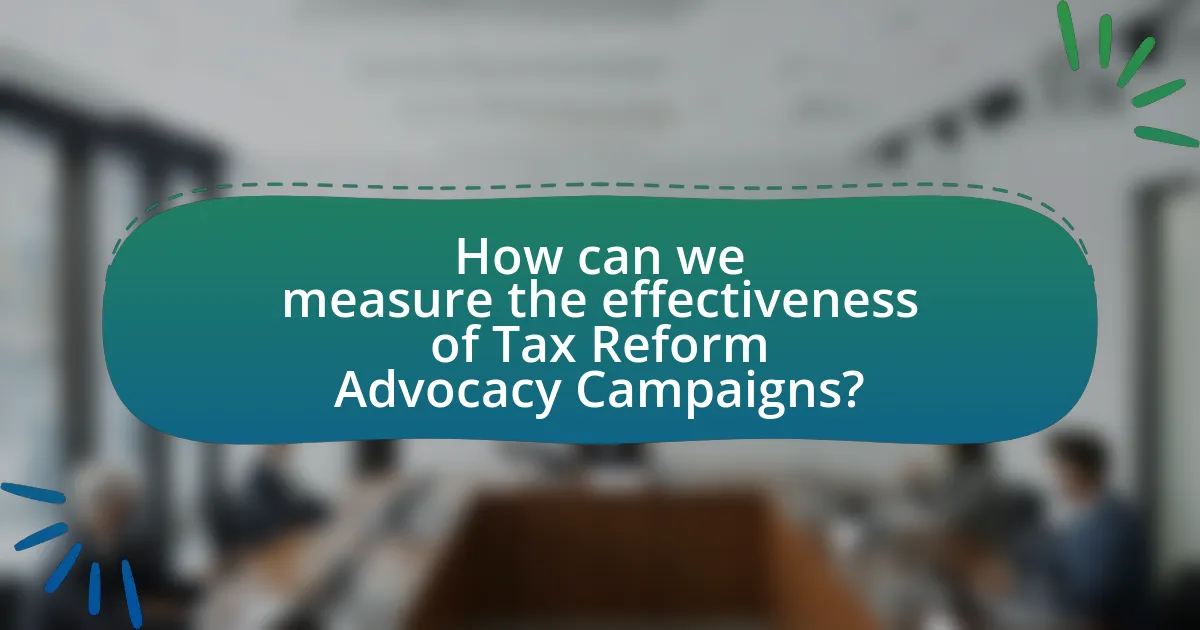
How can we measure the effectiveness of Tax Reform Advocacy Campaigns?
The effectiveness of Tax Reform Advocacy Campaigns can be measured through metrics such as changes in public opinion, legislative outcomes, and engagement levels. Public opinion can be assessed using pre- and post-campaign surveys to gauge shifts in voter attitudes towards tax reform. Legislative outcomes can be evaluated by tracking the introduction, support, and passage of tax reform bills influenced by the campaign. Engagement levels can be measured through metrics like social media interactions, attendance at advocacy events, and the number of grassroots mobilizations. For instance, a campaign that successfully shifts public opinion by 20% in favor of tax reform and results in the passage of related legislation demonstrates effectiveness.
What metrics are used to evaluate campaign success?
Metrics used to evaluate campaign success include return on investment (ROI), engagement rates, conversion rates, and reach. ROI measures the financial return relative to the campaign cost, indicating overall effectiveness. Engagement rates assess how well the audience interacts with the campaign, often measured through likes, shares, and comments. Conversion rates track the percentage of individuals who take a desired action, such as signing a petition or donating, reflecting the campaign’s ability to motivate action. Reach quantifies the total number of individuals exposed to the campaign, providing insight into its visibility and potential impact. These metrics collectively offer a comprehensive view of a campaign’s performance and effectiveness in achieving its goals.
How do we assess changes in public opinion?
To assess changes in public opinion, researchers typically employ surveys and polls to gather quantitative data on attitudes and beliefs over time. These methods allow for the measurement of shifts in public sentiment regarding specific issues, such as tax reform, by comparing responses from different time periods. For instance, a Gallup poll conducted before and after a tax reform advocacy campaign can reveal whether public support for the reform has increased or decreased, providing concrete evidence of the campaign’s impact on public opinion.
What indicators show policy changes resulting from campaigns?
Indicators that show policy changes resulting from campaigns include shifts in legislative proposals, changes in public opinion, and alterations in government spending priorities. Legislative proposals reflect the influence of advocacy campaigns when new bills are introduced or existing ones are amended in response to campaign efforts. Public opinion can be measured through polls that indicate increased support for specific tax reforms, demonstrating that campaigns have effectively swayed public sentiment. Additionally, changes in government spending priorities, such as reallocating funds to support tax initiatives promoted by campaigns, serve as concrete evidence of policy shifts. These indicators collectively validate the impact of advocacy campaigns on policy changes.
What challenges do Tax Reform Advocacy Campaigns face in evaluation?
Tax Reform Advocacy Campaigns face significant challenges in evaluation, primarily due to the complexity of measuring their impact on policy change. Evaluators often struggle to isolate the effects of advocacy efforts from other influencing factors, such as economic conditions or political shifts, which can obscure the direct outcomes of the campaigns. Additionally, the lack of standardized metrics for success in advocacy makes it difficult to compare results across different campaigns. For instance, a study by the Center for American Progress highlights that many campaigns do not have clear, quantifiable goals, leading to ambiguous assessments of their effectiveness. Furthermore, the time lag between advocacy efforts and observable policy changes complicates timely evaluation, as immediate results are often not available. These factors collectively hinder the ability to accurately assess the success and impact of Tax Reform Advocacy Campaigns.
How do external factors influence campaign outcomes?
External factors significantly influence campaign outcomes by shaping public perception, media coverage, and political context. For instance, economic conditions can affect voter sentiment, as seen during the 2008 financial crisis, which led to a shift in public support for tax reform initiatives. Additionally, social movements and public opinion trends can either bolster or hinder campaign efforts; the rise of grassroots movements advocating for tax equity has been shown to impact legislative priorities. Furthermore, the role of media in framing issues can determine the visibility and urgency of a campaign, influencing how effectively it resonates with the target audience. These dynamics illustrate that external factors are critical in determining the success or failure of advocacy campaigns.
What limitations exist in measuring campaign effectiveness?
Measuring campaign effectiveness faces several limitations, primarily due to the complexity of isolating variables and attributing outcomes directly to the campaign. For instance, external factors such as economic conditions, public sentiment, and competing messages can significantly influence the results, making it challenging to determine the campaign’s direct impact. Additionally, the reliance on quantitative metrics, such as engagement rates or conversion statistics, may overlook qualitative aspects like changes in public perception or attitudes, which are harder to quantify but equally important. Furthermore, the time lag between campaign implementation and observable outcomes can complicate the assessment, as immediate results may not reflect long-term effectiveness. These limitations highlight the need for a multifaceted approach to evaluation that considers both quantitative and qualitative data to gain a comprehensive understanding of a campaign’s impact.
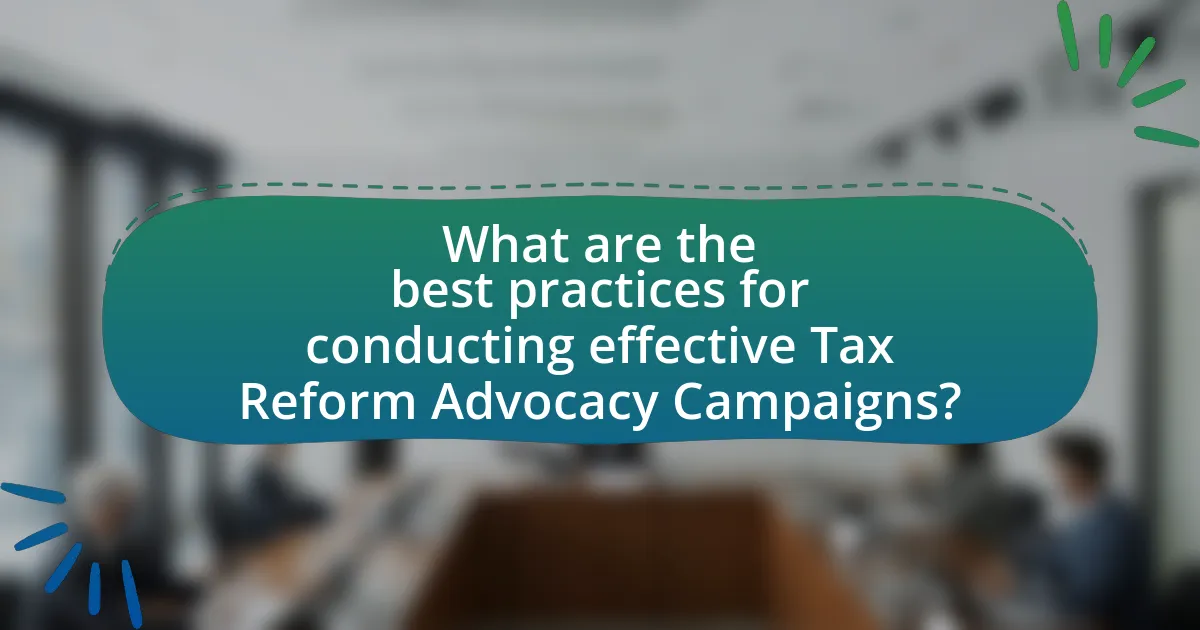
What are the best practices for conducting effective Tax Reform Advocacy Campaigns?
The best practices for conducting effective Tax Reform Advocacy Campaigns include clearly defining the campaign’s objectives, engaging stakeholders, utilizing data-driven messaging, and leveraging multiple communication channels. Clearly defined objectives ensure that the campaign remains focused and measurable, while engaging stakeholders, such as community leaders and affected groups, fosters broader support and collaboration. Data-driven messaging, supported by relevant statistics and case studies, enhances credibility and persuades policymakers by illustrating the potential impacts of tax reform. Additionally, leveraging multiple communication channels, including social media, traditional media, and grassroots organizing, maximizes outreach and mobilizes diverse audiences. These practices are validated by successful campaigns that have effectively influenced tax policy changes, demonstrating the importance of strategic planning and execution in advocacy efforts.
How can campaigns enhance their outreach and engagement?
Campaigns can enhance their outreach and engagement by utilizing targeted messaging and leveraging digital platforms. Targeted messaging ensures that the content resonates with specific demographics, increasing the likelihood of engagement; for instance, campaigns that tailor their messages to address the unique concerns of different voter segments have shown higher response rates. Additionally, leveraging digital platforms such as social media allows campaigns to reach a broader audience quickly and interactively, as evidenced by the 2016 U.S. presidential election, where candidates who effectively used social media saw significant increases in voter engagement and mobilization.
What innovative strategies can be employed for greater impact?
Innovative strategies for greater impact in tax reform advocacy campaigns include leveraging data analytics to target specific demographics effectively. By utilizing data-driven insights, campaigns can tailor their messaging to resonate with the values and concerns of different voter segments, thereby increasing engagement and support. For instance, a study by the Pew Research Center found that targeted messaging can improve voter turnout by up to 20%. Additionally, employing social media platforms for grassroots mobilization allows for real-time interaction and feedback, enhancing community involvement and advocacy effectiveness. Research from the Harvard Kennedy School indicates that campaigns utilizing social media saw a 30% increase in participant engagement compared to traditional methods. These strategies demonstrate a clear pathway to achieving greater impact through informed, targeted approaches.
How can campaigns effectively utilize data and analytics?
Campaigns can effectively utilize data and analytics by leveraging targeted audience insights to tailor messaging and optimize outreach strategies. By analyzing demographic data, behavioral patterns, and engagement metrics, campaigns can identify key segments of the population that are most likely to support tax reform initiatives. For instance, a study by the Pew Research Center found that campaigns that used data analytics to segment their audience saw a 30% increase in engagement rates compared to those that did not. This targeted approach allows for more personalized communication, enhancing the likelihood of mobilizing supporters and influencing public opinion on tax reform.
What lessons can be learned from past Tax Reform Advocacy Campaigns?
Past Tax Reform Advocacy Campaigns demonstrate the importance of building broad coalitions to gain public support, as seen in the 1986 Tax Reform Act, which succeeded due to bipartisan backing. Effective communication strategies, such as clear messaging and addressing public concerns, were crucial in campaigns like the 2017 Tax Cuts and Jobs Act, where framing the narrative around economic growth helped garner support. Additionally, utilizing data and research to substantiate claims proved vital; for instance, the 2012 campaign for the “Buffett Rule” highlighted income inequality and tax fairness, resonating with voters. These campaigns illustrate that successful advocacy requires strategic alliances, effective messaging, and evidence-based arguments to influence policy change.
What successful case studies provide insights into effective strategies?
Successful case studies that provide insights into effective strategies in tax reform advocacy include the 2012 Proposition 30 campaign in California and the 2017 Tax Cuts and Jobs Act advocacy. The Proposition 30 campaign successfully utilized grassroots mobilization and coalition-building, resulting in a tax increase that funded education and public services, demonstrating the power of community engagement and targeted messaging. The 2017 Tax Cuts and Jobs Act advocacy showcased effective use of media and strategic framing, emphasizing economic growth and job creation, which helped garner support from various stakeholders. These case studies illustrate the importance of tailored communication strategies and stakeholder involvement in achieving successful tax reform outcomes.
How can failures inform future campaign approaches?
Failures can inform future campaign approaches by providing critical insights into what strategies did not resonate with the target audience or failed to achieve desired outcomes. Analyzing these failures allows campaigners to identify specific weaknesses, such as ineffective messaging or misaligned goals, which can be adjusted in subsequent efforts. For instance, a study by the Harvard Kennedy School found that campaigns that conducted post-mortem analyses of unsuccessful initiatives were 30% more likely to improve their strategies in future campaigns. This evidence underscores the importance of learning from past mistakes to refine tactics, enhance engagement, and ultimately increase the likelihood of success in future tax reform advocacy campaigns.
What practical tips can enhance the effectiveness of Tax Reform Advocacy Campaigns?
To enhance the effectiveness of Tax Reform Advocacy Campaigns, organizations should focus on clear messaging, grassroots mobilization, and data-driven strategies. Clear messaging ensures that the campaign communicates the benefits and necessity of tax reform in a straightforward manner, making it easier for the public and policymakers to understand the issues at hand. Grassroots mobilization engages community members, fostering a sense of ownership and urgency around the reform, which can lead to increased public support and pressure on decision-makers. Data-driven strategies involve using empirical evidence and case studies to support claims, demonstrating the potential positive impacts of proposed reforms, which can persuade skeptics and strengthen the campaign’s credibility. For instance, campaigns that effectively utilized data, such as the 2017 Tax Cuts and Jobs Act advocacy, showcased specific economic benefits, leading to broader acceptance among various stakeholders.
